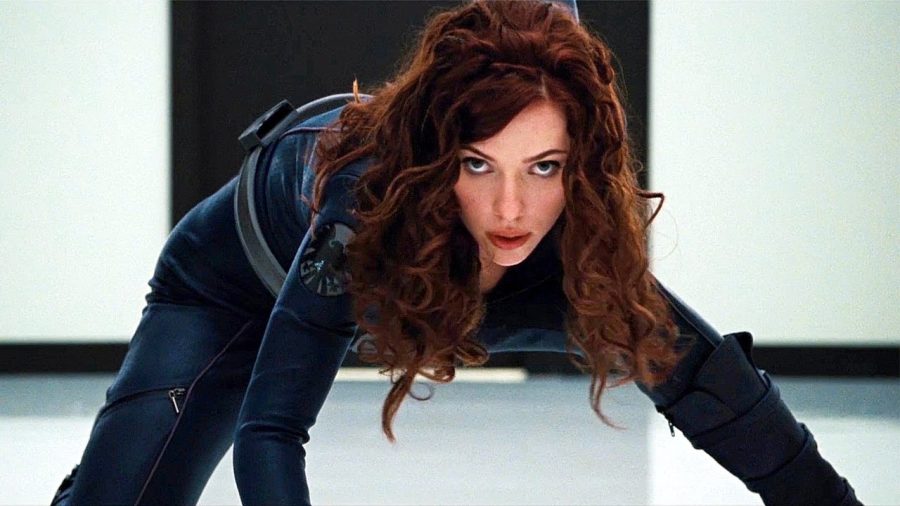Objectification and misogyny in comic book films
Scarlet Johansson as Black Widow in Marvel Studios’ “Iron Man 2”
March 17, 2022
Personally, I am an avid fan of superheroes. I collect comic books, watch superhero films and television, and spend money on comic merchandise. However, I feel that far too often, fans are afraid to critique the media that they consume. I want to point out a glaring issue within this genre, despite my love for it.
It is no secret that comics are pandered to young boys and men. Although, in recent years, more women and girls have participated in “geek” culture, the world of superheroes is still very much a “boys’ club.” Since their debut, heroes like Iron Man and Superman have been a means of projection for male fans. They are the ideal man: strong, powerful, handsome, and masculine. This begs the question; what role do female characters play in these stories? The unfortunate truth is, far too often, female heroines become an object of sexuality rather than a character. To validate my point, I will compare four different films and their depictions of the same female characters.
Unfortunately, you cannot talk about the objectification of female heroes without mentioning Marvel’s Black Widow. Natasha Romanoff, played by Scarlett Johansson, made her film debut in 2010’s “Iron Man 2.” In her first scene, the Russian spy is undercover as Natalie Rushman, an assistant to Tony Stark. Immediately, Tony and his security guard, Happy, begin to ogle the woman. Stark even goes as far as to pull up old modeling photos of her scantily clad. Throughout the film, even after her reveal as a talented spy, Romanoff is presented as little more than eye candy. She runs, shoots, and flips with her skintight catsuit zipped down, hair immaculately curled, and winged liner framing her eyes. All this, while Tony Stark is shown being dirty, bloodied, and in practical armor.
Now, contrast Romanoff’s first appearance with her final one in 2021’s “Black Widow.” This overdue solo film explores Natasha’s revenge on the cruel Red Room and its ringleader. Throughout the film, Natasha is portrayed as refreshingly human. She wears little makeup, keeps her hair pulled back, and wears a more practical suit. The film explores her trauma, family bonds, and her desperate attempts to redeem her past. She feels like more than Black Widow. She serves as more than a sexual object. She is a real person! She laughs, cries, eats sandwiches, watches films, and fights with her family! And the entire time, she is still just as beautiful as she was in “Iron Man 2.” Only now she is a beautiful person, rather than a beautiful thing.
My second example begins with 2016’s “Suicide Squad.” This film served as Harley Quinn’s, played by Margot Robbie, film debut. Throughout the movie, she is unabashedly objectified by her majority male team members. Her first scene shows her scantily clad, performing an impromptu gymnastics routine. Later on, she puts on a thin shirt, booty shorts and sky high heels. She wears a jacket that reads “Property of the Joker.” Harley Quinn belongs not only to the Joker, but to all her male counterparts who ogle her, and for the male audience that watches her.
When compared to her second film appearance, 2020’s “Birds of Prey,” the differences are not apparent. Throughout this film, Harley does not dress modestly. She wears cropped tops, short shorts, high shoes, and flashy makeup. How is this different? The answer lies in two components of the film: the costume design and Harley’s characterization. Firstly, Harley’s clothes are fun. They match her eccentric personality. She wears sparkly capes, roller skates, and metallic overalls. Her wardrobe is just as bright and crazy as she is. Harley is not being dressed for the viewer’s pleasure, but for her own. And this shows in her character! In this film, she is more than a two-dimensional love interest. We get to watch as she spontaneously cuts her hair, plays roller derby, and salivates over a breakfast sandwich. Harley Quinn is so fun! And as was the case with Natasha Romanoff, she is still beautiful.
So, what makes the difference? How can audiences differentiate between objectification and characterization? Personally, I believe the key is to think critically about the media we consume. Consider the female characters in your media, watch how they are filmed and how they interact with the men around them. You might notice a few things.


